Alternative names Piroshki
Pyrizhky Place of origin Eastern Europe | Variations Multiple Serving temperature Warm or hot | |
 | ||
Course Dessert, Hors d'oeuvre, Main course Main ingredients Yeast dough, Various fillings Similar Pelmeni, Borscht, Zakuski, Varenyky, Chebureki | ||
Pirozhki (Russian: пирожки, plural form of pirozhok, literally a "small pie"), also transliterated as piroshki (singular piroshok) or pyrizhky (Ukrainian: пиріжки), is a generic word for individual-sized baked or fried buns stuffed with a variety of fillings. The stress in pirozhki is properly placed on the last syllable: [pʲirɐʂˈkʲi]. Pirozhok ( пирожок , singular) is the diminutive form of the Russian pirog (пирог), which refers to a full-sized pie. (Unless the full-sized pie is called by the diminutive name for purely stylistic reasons.) Pirozhki are not to be confused with the pierogi of Poland and Eastern Europe, which are boiled dumplings practically identical to the Ukrainian and Russian varenyky.
Contents
- The Balkans
- The Baltic region
- Finland
- Central Asia
- East Asia
- Caucasus and Iranian Azerbaijan
- Iran
- Japan
- The Americas
- References
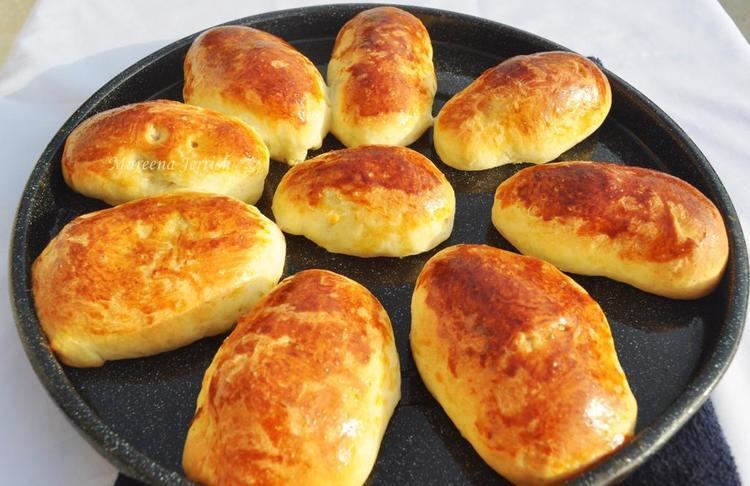
A common variety of pirozhki are baked stuffed buns made from yeast dough and often glazed with egg to produce the common golden colour. They commonly contain meat (typically beef) or a vegetable filling (mashed potatoes, mushrooms, onions and egg, or cabbage). Pirozhki could also be stuffed with fish (e.g., salmon) or with an oatmeal filling mixed with meat or giblets. Sweet-based fillings could include stewed or fresh fruit (apples, cherries, apricots, chopped lemon, etc.), jam, quark or cottage cheese. The buns may be plain and stuffed with the filling, or else be made in a free-form style with strips of dough decoratively encasing the filling.
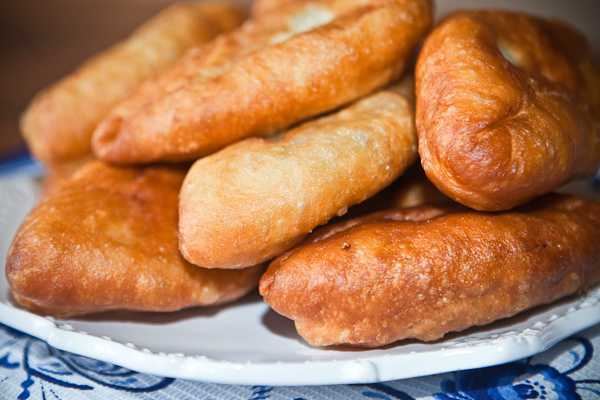
Variations on the use of yeast dough can be American style pie crust short dough or multilayered pastry dough similar to that found in croissants.
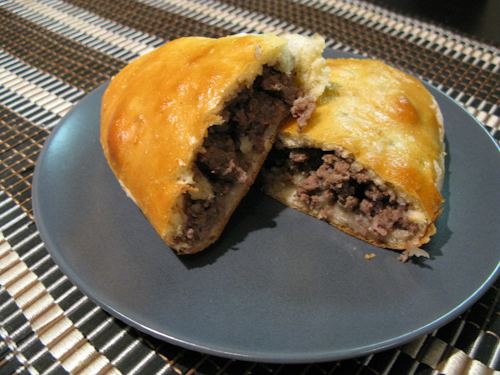
Piroshki can be of a reasonable size, slightly smaller than a hamburger, with several eaten as a meal unto themselves. Another version is smaller, about the size (width and length) of two fingers, and is usually served in pairs accompanying soup.
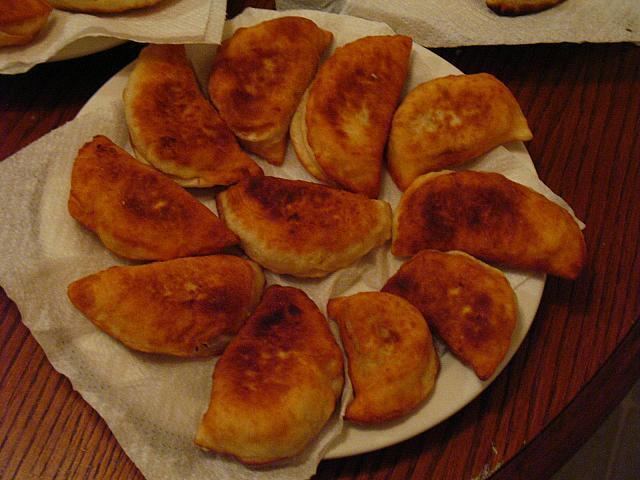
Potatoes among American crops became very popular when the vegetable was brought and adopted to the Eurasian climate. Before then, the ingredient was not available as it took more time to acclimatize to continental regions like Russia and Ukraine. Before then, the ingredients would contain more vegetables and fruits, as well as duck, goose and rabbit meat, uncommon today.
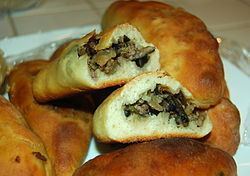
The Balkans
The Greek variety piroski (Greek: πιροσκί) is popular in parts of Greece influenced by eastern cuisine and in most big cities, where they are sold as a type of fast food. The Greek piroski come deep-fried with many different stuffings.
In Serbia the local variety are cylindrical pastries called piroška. They are stuffed with fillings such as ground spiced meat mix of pork and veal or cottage cheese, and with kulen, tomato sauce and herbs. Alternatively they are made from breaded crepes with variety of fillings.
The Baltic region
In Latvia crescent-shaped buns of leavened dough called pīrāgi (often referred to in diminutive pīrādziņi) or speķa rauši (literally, "bacon tarts") are traditionally filled with bacon and onion. Other fillings are also possible. However the name pīrāgi is not exclusive to these buns, but can refer to variety of other pastries, such as pies and turnovers. Pīrāgi were often eaten as lunch by farmers and shepherds working the fields.
Estonians too have this tradition. The pirukad are fairly small in size and have regional variations in respect to fillings. Pirukad are sometimes accompanied by bouillon. Many recipes exist, with meat, cabbage, carrots, rice, egg and other fillings and filling mixtures also being used. The Latvian bacon and onion version is known to Estonians, but is not as common. One can also encounter sweet fillings, although savory pirukad predominate.
Finland
Karelian pasties (karjalanpiirakat or karjalanpiirakka in the South Karelian dialect of Finnish and karjalanpiiraat or karjalanpiiras in the North Karelian dialect) are a differently shaped pie popular in both Karelia and Finland. Compared to the Baltic pirukas and pīrāgi, the Karelian pastries are open-faced.
Central Asia
Pirozhki are common as fast food on the streets of the Central Asian countries in Kazakhstan, Tajikistan, Uzbekistan, Turkmenistan, Kyrgyzstan, Mongolia, where they were introduced by the Russians. They are also made by many Russians and non-Russians at home.
East Asia
Pirozhki is also very common as fast food in Mongolia, and it is made throughout the country by families at home.
Caucasus and Iranian Azerbaijan
The Russian variant of Pirozhki is a common fast food in Armenia and Azerbaijan. In Armenia it often contains a potato or seasoned meat filling. In Azerbaijan, it is often eaten as a dessert and is commonly filled with cream.
Iran
An Iranian version, called پیراشکی (pirāški) is often eaten as a dessert or as a street food. It is commonly filled with cream, but potato and meat fillings are also available in some shops. The Iranian sweet shops in Los Angeles have invented other versions such as chocolate and blueberries.
Japan
A Japanese version, called ピロシキ (piroshiki), are predominantly fried, use fillings such as ground meat, boiled egg, bean noodles, spring onion etc., and are commonly breaded with panko before frying, in the manner of Japanese menchi-katsu. Another popular variation is filled with Japanese curry and is quite similar to karē-pan, which is itself said to be inspired by pirozhki.
The Americas
Varieties of pirozhki were brought to the Americas by Volga Germans. Known today as bierock, pirok or runza, they belong to several regional cuisines in the United States, Canada and Argentina. Of course, the populous Russian diaspora which came to the Americas as a consequence of the Russian Revolution and Civil War and later unfortunate events brought with them the more classic Russian versions of piroshki.
